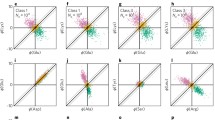Abstract
Two possibilities exist for the evolution of individual enzymes/proteins from a milieu of amino acids, one based on preference and selectivity and the other on the basis of random events. Logic is overwhelmingly in favour of the former. By protein data base analysis and experiments, we have provided data to show the manifestation of two types of preferences, namely, the choice of the neighbour and its acceptance from the amino end (left) or the carboxyl end (right). The study tends to show that if the 20 proteinous amino acids were made to combine in water, the resulting profile would be nonrandom. Such selectivity could be a factor in protein evolution.
Similar content being viewed by others
References
Bernal J D 1967The origin of life (London: Weidenfeld and Nicolson)
Bodanzky M and Bodanzky A 1994The practice of peptide synthesis (New York: Springer Verlag)
Chou P Y 1989 Prediction of protein structural classes from amino acid composition; inPrediction of protein structure and the principles of protein conformation (ed.) G D Fasman (New York: Plenum Press) pp 549–558
Creighton T E 1984Proteins: Structure and molecular principle (New York: Freeman)
Doolittle R 1989 Similar amino acid sequences revisited;TIBS 14 244–245
Dose K, Hartmann J and Brand M C 1982 Formation of specific amino acid sequences during carbodiimide mediated condensation of amino acids in aqueous solutions;Biosystems 15 195–200
Erhan S 1978 Systematics: Use of protein nearest neighbor frequency distribution as an objective key;Int. J. Bio-Med. Comput. 9 115–125
Harada K and Fox S W 1965 Thermal polycondensation of free amino acids with polyphosphoric acid; inThe origins of prebiological systems and of their molecular matrices (ed.) S W Fox (New York: Academic Press) pp 289–298
Kolaskar A S and Ramabrahmam V 1982 Obligatory amino acids in primitive proteins:Biosystems 15 105–109
Kricheldori H R, Au M and Mang T 1985 Models of molecular evolution;Int. J. Peptide Protein Res. 26 149–157
Orgel L E 1992 Molecular replication;Nature (London) 358 203–209
Ranganathan S, Kundu D and Tamilarasu N 1999 Protein evolution: The deciphering of latent facets -correlation of synthesis profiles of ribosomally directed proteins and enzyme directed peptides;J. Biosci. 24 103–113
Ranganathan S and Ranganathan D 1981 Self organizing systems: Evolution of the genetic apparatus;Trans. Bose Res. Inst. 44 109–116
Rani M and Mitra C K 1994 Periodicities in protein sequences;J. Biosci. 19 255–266
Rani M and Mitra C K 1996 Pair preferences: A quantitative measure of regularities in protein sequences;J. Biomol. Struct. Dynam. 13 935–944
Tyagi S and Ponnamperuma C 1990 Non randomness in prebiotic peptide synthesis;J. Mol. Evol. 30 391–399
Vijayan M 1988 Molecular interactions and aggregation involving amino acids and peptides and their role in chemical evolution;Prog. Biophys. Mol. Biol. 52 71–99
Villar H O and Kauvar M 1994 Amino acid preferences at protein binding sites;FEBS Lett. 349 125–130
Vonderviszt F, Matrai G Y and Simon I 1986 Characteristic sequential residue environment of amino acids in proteins;Int. J. Peptide Protein Res. 27 483–492
Walder J A, Walder R Y, Heller M J, Freier S M, Letzinger R and Klotz I M 1979 Complementary carrier peptide synthesis: General strategy and implications for prebiotic origin of peptide synthesis;Proc. Natl. Acad. Sci. USA 76 51–55
Author information
Authors and Affiliations
Corresponding author
Additional information
Dedicated to the memory of Darshan Ranganathan.
Rights and permissions
About this article
Cite this article
Ranganathan, S., Kundu, D. & Vudayagiri, S.D. Protein evolution: intrinsic preferences in peptide bond formation: a computational and experimental analysis. J Biosci 28, 683–690 (2003). https://doi.org/10.1007/BF02708428
Received:
Accepted:
Issue Date:
DOI: https://doi.org/10.1007/BF02708428




